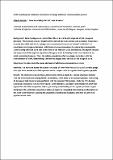Por favor, use este identificador para citar o enlazar a este item:
http://hdl.handle.net/10261/207029COMPARTIR / EXPORTAR:
 SHARE
BASE SHARE
BASE
|
|
| Visualizar otros formatos: MARC | Dublin Core | RDF | ORE | MODS | METS | DIDL | DATACITE | |

| Título: | Unveiling the molecular mechanism of phage arbitrium communication system |
Autor: | Marina, Alberto CSIC ORCID ; Gallego del Sol, Francisca CSIC ORCID; Penadés, José R. CSIC ORCID | Fecha de publicación: | 7-jul-2019 | Citación: | 8th Congress of European Microbiologist. FEMS (2019) | Resumen: | (Oral 100) Background: Bacteriophages can control their life cycles via density-dependent lytic-lysogenic decisions. This decision severely impacts both viral and bacterial ecology and evolution. It has been recently described that Bacillus phages use a communication system, termed ¿arbitrium¿, to coordinate lysis-lysogeny decisions. Arbitrium system communicates by producing a hexapeptide (AimP) during their lytic cycle that is secreted to the medium. Once internalized, the peptide reduces the expression of the negative regulator of lysogeny AimX by binding to the transcription factor AimR, promoting lysogeny. Thus, the relative population of active phages correlates with the concentration of AimP, determining whether the phages enter the lytic or the lysogenic cycle. Objectives: To understand the molecular basis of arbitrium communication system, Methods: We have elucidated the crystal structures of AimR from the Bacillus subtilis SPbeta phage in its apo form, bound to its DNA operator and in complex with its cognate AimP regulator peptide. Results: The structures showed that AimR presents intrinsic plasticity, sharing structural features with the RRNPP quorum sensing family. Remarkably, AimR binds to an unusual operator with a long 25 bp spacer that interacts nonspecifically with the receptor TPR domain, while the HTH domain canonically recognizes two inverted repeats. AimP stabilizes a compact conformation of AimR that approaches the DNA-recognition helices, preventing AimR binding to its cognate promoter region. Intriguingly the AimR DNA-recognition helices remain in a compatible DNA-binding conformation in the AimR-AimP structure, opening the possibility of additional regulatory activities of AimR in its peptide-bound state. | Descripción: | Abstract de la comunicación oral presentada al 8th Congress of European Microbiologist. FEMS 2019. Glasgow, Scotland. 7-11 July 2019 | URI: | http://hdl.handle.net/10261/207029 |
| Aparece en las colecciones: | (IBV) Comunicaciones congresos |
Ficheros en este ítem:
| Fichero | Descripción | Tamaño | Formato | |
|---|---|---|---|---|
| 2019 fems 95.pdf | 262,92 kB | Adobe PDF |  Visualizar/Abrir |
CORE Recommender
Page view(s)
131
checked on 30-may-2024
Download(s)
81
checked on 30-may-2024
Google ScholarTM
Check
NOTA: Los ítems de Digital.CSIC están protegidos por copyright, con todos los derechos reservados, a menos que se indique lo contrario.
